
Wine Culture and Information since 2002 - Volume 22
 Wine Culture and Information since 2002 - Volume 22 |
|
Issue 71, February 2009 |
Contents |
|
|
Quality Without Frontiers |
|
Maybe it is because of the economic crisis of these times, or maybe for reasons of chauvinism, in Italy is getting more and more common to strenuously defend and support local production, inviting consumers to prefer local products while avoiding foreign ones. The reasons used to convince consumers to prefer Italian products are many. Including the supposed superiority of Italian products over foreign ones, as if quality is a prerogative unique to Italy and in the other countries are produced inferior things only. The funny thing is that, according to the ones who suggest these behaviors, one should always prefer Italian products, not only for a silly chauvinist and patriotic spirit, but also because this is certainly and undoubtedly better. Who do Italian think they are in order to be convinced they are the only ones in the world capable of producing things of impeccable quality, in particular food? We should maybe make these persons remember in Italy not all the shiny things are made of gold and that in this country - just like any other country of the world, after all - have been discovered huge food frauds. It has in fact happened products of certified quality were made with low quality ingredients or - even worse - used despite they were not suited for eating. Moreover, there are cases of evident incongruity, products - and wines - which are ranked to the highest “legal” quality and that, when tasted, they can barely be defined as ordinary. However, according to the logic of some, these are products to be bought and consumed for the simple reason they are made in Italy. We think we must be clear about this: Italy is a country rich in food resources, absolutely unique and of high quality, products having no equals in the world. The same can be however and certainly be said for any other country: every place - as well as every person - has something unique, incomparable and unrepeatable to offer. This does not however mean “better”, because quality needs other factors in order to be expressed, last but not the least, honesty, culture and capacity of the one who makes it. In case the advice, proposed with arrogance, as if it was a sort of menace, must be followed in order to protect the economic interests of corporations, the temptation to buy and consume other products is very strong. Words are not enough to make quality, and it is not even enough the silly chauvinist spirit: it takes facts and not speculations, in particular economic and cultural ones. For what reason one should prefer a mediocre Italian product when one can get a better product coming from another country, and even sold at a more honest and accessible price? Only because it is Italian? We don't believe this is enough. Quality has no frontiers and no flags. Let's begin to reward the ones who behave in a serious and worthy way. Consumers have a huge power over producers, something which can be clearly expressed through purchase. In case a foreign product is better than the analogous Italian one, for what reason one should reward the producer who shows a lower capacity in offering quality? One should buy better products instead - provided prices are reasonable and appropriate - in order to reward the ones who truly deserve to be rewarded. The silly principle supporting the idea anything produced in a determined country is indisputably better, reveals - as a matter of fact - a huge cultural ignorance and an intellectual arrogance, supported by the hypocrite presumption of the ones who believe to be “better” because he or she does not know anything about what happens outside the borders of his or her tiny territory. Anyone is free to set the borders of his or her world, however no one can impose the same limits and his or her limited vision of the world to others. As every world is a world on its own, one should be sufficiently intelligent to understand there is nothing absolute and everything and “every world” has something to offer and from which one can learn from. Diversity is a great richness from which one always learns something. As there is nothing absolute, this is also true for quality. Everything has its own characteristics and qualities, therefore saying what is the best one is, after all, a simple and indisputable mater of opinion, taste and culture. As to make an example - one of the most common ones - it makes no sense to say Champagne is better than Franciacorta and vice versa. They are both excellent products: each one expressing its own unique qualities which are also the result of unrepeatable conditions exclusively found in their respective territories. What offends the most is when one tries to justify the lack of quality with matters of chauvinism and patriotism. Not only this offends the dignity and the intelligence of consumers by using disputable sentimental matters, this also offends producers who make real quality and for this reason they are not rewarded. If we consider the specific case of Italy, they first suggest consumers to prefer Italian products, therefore, when the message has been spread, every region begins to strenuously suggest consumers to buy its products, by saying they are better than the ones produced in other regions. The system continues with provinces, corporations and cities, down to the smallest part of territory: every one tries to make its own interests, every one tries to fortifies its own borders while avoiding dangerous invasions from the outside. Comparing and knowledge is a good way out for consumers who rightly try and understand products coming from other countries and cultures. And, at the end, they should reward the ones who are worth of trust by showing facts. Quality has no frontiers. And it has no flags, too.
|
||||
Comparing Nebbiolo d'AlbaAlba, capital city of Langhe, besides being renowned for its good cuisine, offers valuable wines produced with typical Piedmontese grapes, including Nebbiolo |
|
You talk about Nebbiolo and you think about Piedmont and, in particular, about some villages, all located in that magnificent wine land called “Langhe”. In particular, two are the cities of Langhe mainly associated to Nebbiolo - Barolo e Barbaresco - which have brought the name of the famous Piedmontese grape all over the world. However, in the Langhe is found another city, considered the capital city of this area, rich in resources, excellent cooking and, last but not the least, excellent wines: Alba. The wines of this area are in fact ranked as Denominazione d'Origine Controllata (DOC, Denomination of Controlled Origin) by a specific disciplinary and for the production are used the three most famous red berried grapes of Langhe and Piedmont: Dolcetto, Barbera and, of course, Nebbiolo. Strong of the wine making tradition of Langhe, including the particular territory and climate of the area, Nebbiolo d'Alba usually brings nice surprises, and sometimes one may wonder whether the wine is truly a Nebbiolo d'Alba or a Barolo or a Barbaresco. The production area of Nebbiolo d'Alba is pretty wide and includes the territories of the noble DOCG wines Barolo, Barbaresco and Roero. Thanks to the size of the production area, the organoleptic qualities of Nebbiolo d'Alba are pretty variegated, from medium bodied wines to full bodied wines. If we add the many wine making techniques used for its production to the specific qualities of the territory, Nebbiolo d'Alba offers very rich organoleptic and sensorial profiles. Nebbiolo, one of the most famous and noble grapes of the Italian wine scene, is characterized by a pretty high acidity and it is among the grapes having the highest content in polyphenols. For these reasons, the most typical choice adopted by producers - including Nebbiolo d'Alba - is to ferment and age the wine in cask, and frequently the barrique as well, in order to smooth the typical harshness of the grape.
|
|
According to the production disciplinary, Nebbiolo d'Alba must be exclusively produced with the homonymous grape and must be aged for at least one year before commercialization. Despite the production disciplinary does not provide for any indication about the type of container to be used for aging, Nebbiolo d'Alba is mainly aged in cask, however there are also cases in which the aging in done in barrique. Moreover, the production disciplinary provides for a “sparkling” style, however most of Nebbiolo d'Alba is produced as dry. Thanks to the specific qualities of the grape, this wine can evolve in the bottle for many years, developing complex organoleptic qualities and, at the same time, smoothing the typical astringency of the grape. One of the many interesting aspects of Nebbiolo d'Alba is represented by price: a high quality frequently sold at a more accessible price than the other famous wines produced with Nebbiolo grape.
Our comparative tasting has the goal of studying the qualities of Nebbiolo grape produced in the wide DOC area of Alba, for this reason the three wines selected are all aged in cask, in order to limit the woody impact which frequently characterizes wines aged in barrique. The first wine is Prunotto's Nebbiolo d'Alba Occhetti, aged for 12 months in cask. The second wine of the comparative tasting is Sandrone's Nebbiolo d'Alba Valmaggiore, also in this case aged in cask for 12 months. The third wine is Matteo Correggia's Nebbiolo d'Alba La Val dei Preti, aged in cask for a longer period then the two previous wines, in this case for about 20 months. The wines will be selected according to the most recent vintages available in the market and will be served at the temperature of 18°C (64°F), in order to limit the impact of astringency in favor of roundness. For the comparative tasting will be used three ISO tasting glasses.
|
||||||||
|
Wines produced with Nebbiolo grape are generally characterized by a moderate transparency and by pretty brilliant colors. Because of the modest content in coloring substances, this is in fact what can be observed in most of the wines produced with the famous Piedmontese grape. A lower transparency is however possible in Nebbiolo, a result which however needs high quality viticultural and wine making techniques, with pretty low yields in vineyard. The color of wines produced with Nebbiolo is generally very brilliant, showing in its youth evident ruby red hues and nuances of the same color. After some years of aging in bottle, nuances begin to show a garnet red hue and, sometimes, brick red. This quality could make one think about a quick aging of the wine, however the longevity of Nebbiolo - thanks to the high content in tannins, acidity and alcohol - is pretty long, sometimes for tens of years. We will begin the appearance analysis of our comparative tasting from Prunotto's Nebbiolo d'Alba Occhetti. By holding the class tilted over a white surface - to this purpose is enough a simple sheet of paper of a white tablecloth - we will observe the color at the base of the glass. The color of this first wine is brilliant ruby red with a moderate transparency. By observing the wine at the edge, towards the opening of the glass, we will appreciate garnet red nuances. The color of the second wine - Sandrone's Nebbiolo d'Alba Valmaggiore - is not so different from the previous one, also in this case it will be observed a brilliant ruby red color and a moderate transparency, and the nuance will show a garnet red color as well. Let's now pass to the third wine of the comparative tasting: Matteo Correggia's Nebbiolo d'Alba La Val dei Preti. The color is pretty similar to the previous wines - intense ruby red and garnet red nuances - however it is the transparency to be different from the other wines, being lower in this case.
|
|
To the nose, wines produced with Nebbiolo are always generous and give pleasing and intense aromas of flowers and fruits, moreover, thanks to the long aging times in wood, pretty complex tertiary sensations as well. The choice of the traditional cask in favor of the more modern barrique, allows the wine to properly age without excessively covering the aromatic qualities of the grape. The opening aromas of Nebbiolo d'Alba are generally cherry, plum and violet, the same aromas which are found in other wines produced with this grape. Among the other fruit aromas are mentioned raspberry, black cherry, blackberry, blueberry and strawberry, whereas for flower aromas, the most frequent ones are rose and geranium. The aging in wood gives Nebbiolo d'Alba tertiary aromas, of which the most frequent ones are vanilla, chocolate, cocoa, licorice, cinnamon and tobacco. In this wine can also be perceived aromas of aromatic herbs, such as thyme and rosemary, as well as the pleasing balsamic touch of menthol. The phase of the olfactory evaluation of our comparative tasting begins from Prunotto's Nebbiolo d'Alba Occhetti. By holding the glass in vertical position, and without swirling, we will do a first smell by keeping the nose in the center of the glass. This first operation will allow the evaluation of the opening olfactory qualities, made from light aromas which volatilize with a small quantity of oxygen. From the glass will be perceived intense and clean aromas of cherry, raspberry, plum and violet, qualities which represent the typical opening in wines produced with Nebbiolo grape. We will now proceed with the swirling of the glass - therefore favoring the oxygenation of the wine and the development of the other aromatic qualities - and we will do a second smell. From the glass are perceived clean aromas of rose and strawberry to which follow complex aromas of vanilla, licorice, cinnamon and chocolate. Let's now pass to the evaluation of the second wine: Sandrone's Nebbiolo d'Alba Valmaggiore. The opening aromas of this wine are not different from the previous one: also in this case are perceived intense and clean aromas of cherry, plum and violet. After having swirled the glass, we will proceed with a second smell which will complete the olfactory profile of the wine with raspberry, rose, blueberry, tobacco, cinnamon, vanilla, licorice, pink pepper and a pleasing balsamic touch of menthol. The opening of the third wine - Matteo Correggia's Nebbiolo d'Alba La Val dei Preti - confirms the typicality of wines produced in this area with intense and clean aromas of ripe cherry, plum and violet. After having swirled the glass, the second smell allows us to complete the olfactory profile of the wine with blueberry, strawberry, tobacco, vanilla and cocoa, as well as pleasing hints of thyme and star anise, to which is added the pleasing balsamic touch of menthol.
|
||||
|
Nebbiolo is not a simple grape and also the tasting shows its remarkable personality and complexity. The tasting of Nebbiolo can in fact leave the taster surprised - either in positive or negative way - as its evident acidity, as well as its evident astringency, are qualities which are rarely found in red wines. Wines produced with Nebbiolo also have pretty high quantities of alcohol - cases in which it is higher than 13.5% are not rare - a characteristic frequently useful for balancing both acidity and astringency of tannins. Also the aging in wood, besides allowing a proper development of the wine, is useful for balancing the “hard” organoleptic qualities of the wine, while giving roundness and smoothness. The attack of Nebbiolo d'Alba is therefore characterized by a pretty evident acidity and astringency, therefore continuing the gustatory perception with the burning sensation of alcohol, followed by roundness, a sensation variable according to time and aging technique. The first wine of which we will evaluate its gustatory profile is Prunotto's Nebbiolo d'Alba Occhetti. The attack confirms the typical qualities of Nebbiolo, astringency and acidity in evidence, promptly balanced by alcohol and roundness developed during the aging in cask. Also the attack of the second wine of our comparative tasting - Sandrone's Nebbiolo d'Alba Valmaggiore - fully interprets the qualities of the noble Piedmontese grape, with well perceptible astringency and acidity, also in this case well balanced by the effects of alcohol and roundness, in this wine being more evident than the previous one. Let's now pass to the evaluation of the third wine: Matteo Correggia's Nebbiolo d'Alba La Val dei Preti. The attack of this Nebbiolo is tannic and supported by a pleasing crispness, well balanced by alcohol and by an appreciable roundness. It should be noticed, in all the three wines, the sensation of structure perceptible in the mouth, robust and full, confirming, once again, the characteristics of Nebbiolo.
|
|
Although we are not discussing about the great names produced with the great red berried Piedmontese grape, the three Nebbiolo d'Alba wines of our comparative tasting fully confirm the qualities of this noble variety. The finish of Prunotto's Nebbiolo d'Alba Occhetti is persistent, leaving in the mouth pleasing and intense flavors of cherry, plum and raspberry. The finish of the second wine - Sandrone's Nebbiolo d'Alba Valmaggiore - is persistent leaving in the mouth intense and clean flavors of cherry, plum, raspberry and blueberry, with a “fuller” sensation than the previous wine. Also the finish of the third wine, Matteo Correggia's Nebbiolo d'Alba La Val dei Preti, is persistent leaving in the mouth pleasing and intense flavors of cherry, plum and blueberry, also in this case a sensation of full and robust structure. Finally, it should also be compared the impact and the contribution of the aging in cask according to the different times and how this affects the roundness of the wine.
|
Wines of the Month |
|
|
|
Score legend Prices are to be considered as indicative. Prices may vary according to the country or the shop where wines are bought |
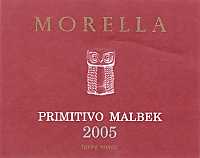
|
|
Primitivo Malbek 2005 |
|
| Morella (Apulia, Italy) | |
| Grapes: Primitivo (85%), Malbec (15%) | |
| Price: € 15.80 | Score: |
| Primitivo Malbek shows an intense ruby red color and nuances of ruby red, little transparency. The nose reveals intense, clean, pleasing and refined aromas which start with hints of plum, black cherry and blackberry followed by aromas of violet, vanilla, cocoa, tobacco, white pepper and menthol. The mouth has good correspondence to the nose, a tannic attack and however balanced by alcohol, good body, intense flavors, agreeable. The finish is persistent with flavors of plum, black cherry and blackberry. This wine ages for 12 months in barrique followed by at least 8 months of aging in bottle. | |
| Food Match: Roasted meat, Broiled meat and barbecue, Stewed and braised meat, Hard cheese | |
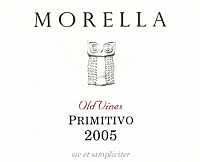
|
|
Primitivo Old Vines 2005 |
|
| Morella (Apulia, Italy) | |
| Grapes: Primitivo | |
| Price: € 20.00 | Score: |
| Primitivo Old Vines shows an intense ruby red color and nuances of ruby red, little transparency. The nose reveals intense, clean, pleasing, refined and elegant aromas which start with hints of plum, blackberry and black cherry followed by aromas of vanilla, violet, tobacco, blueberry, carob, cinnamon, mace and menthol. The mouth has good correspondence to the nose, a tannic attack and however balanced by alcohol, full body, intense flavors, pleasing roundness. The finish is persistent with flavors of plum, blackberry and black cherry. A well made wine. Primitivo Old Vines ages for 14 months n barrique followed by at least 12 months of aging in bottle. | |
| Food Match: Game, Roasted meat, Stewed and braised meat, Hard cheese | |

|
|
Bianco Roccafiore 2006 |
|
| Roccafiore (Umbria, Italy) | |
| Grapes: Grechetto | |
| Price: € 13.00 | Score: |
| Bianco Roccafiore shows a brilliant golden yellow color and nuances of straw yellow, very transparent. The nose denotes intense, clean, pleasing and refined aromas that start with hints of apple, plum and vanilla followed by aromas of toasted, pear, hazelnut and hawthorn. The mouth has good correspondence to the nose, a crisp attack and however balanced by alcohol, good body, intense flavors. The finish is persistent with flavors of apple, plum and hazelnut. Bianco Roccafiore ages for 12 months in cask. | |
| Food Match: Stuffed pasta, Mushroom soups, Roasted white meat, Broiled fish | |

|
|
Rosso Roccafiore 2006 |
|
| Roccafiore (Umbria, Italy) | |
| Grapes: Sangiovese | |
| Price: € 15.00 | Score: |
| Rosso Roccafiore shows a brilliant ruby red color and nuances of ruby red, moderate transparency. The nose denotes intense, clean, pleasing and refined aromas which start with hints of black cherry, plum and violet followed by aromas of blueberry, vanilla, carob and menthol. The mouth has good correspondence to the nose, a tannic attack and pleasing crispness, however balanced by alcohol, good body, intense flavors. The finish is persistent with flavors of plum, black cherry and blueberry. Rosso Roccafiore ages for 12 months in barrique. | |
| Food Match: Stewed meat with mushrooms, Broiled meat and barbecue, Roasted meat | |
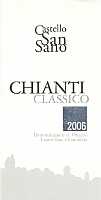
|
|
Chianti Classico Sansano 2006 |
|
| Castello di San Sano (Tuscany, Italy) | |
| Grapes: Sangiovese (90%), Canaiolo Nero (10%) | |
| Price: € 9.50 | Score: |
| Chianti Classico Sansano shows an intense ruby red color and nuances of ruby red, moderate transparency. The nose denotes intense, clean, pleasing and refined aromas that start with hints of black cherry, plum and violet followed by aromas of blueberry, tobacco, vanilla and cocoa. The mouth has good correspondence to the nose, a tannic attack and however balanced by alcohol, good body, intense flavors. The finish is persistent with flavors of plum, black cherry and blueberry. Chianti Classico Sansano ages for 12 months in barrique followed by at least 6 months of aging in bottle. | |
| Food Match: Broiled meat and barbecue, Roasted meat, Stewed meat with mushrooms | |

|
|
Chianti Classico Riserva Guarnellotto 2005 |
|
| Castello di San Sano (Tuscany, Italy) | |
| Grapes: Sangiovese (90%), Canaiolo Nero (10%) | |
| Price: € 18.00 | Score: |
| Chianti Classico Riserva Guarnellotto shows a brilliant ruby red color and nuances of ruby red, little transparency. The nose reveals intense, clean, pleasing and refined aromas which start with hints of black cherry, plum and violet followed by aromas of vanilla, raspberry, blueberry, tobacco, chocolate, mace and menthol. The mouth has good correspondence to the nose, a tannic attack and however balanced by alcohol, good body, intense flavors. The finish is persistent with flavors of black cherry, plum and blueberry. Chianti Classico Riserva Guarnellotto ages for at least 15 months in cask followed by an aging in bottle of at least 12 months. | |
| Food Match: Roasted meat, Braised and stewed meat with mushrooms, Hard cheese | |
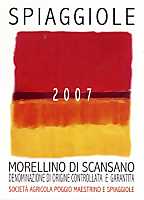
|
|
Morellino di Scansano Spiaggiole 2007 |
|
| Poggio Maestrino Spiaggiole (Tuscany, Italy) | |
| Grapes: Sangiovese (90%), Cabernet Sauvignon (5%), Merlot (5%) | |
| Price: € 9.50 | Score: |
| Morellino di Scansano Spiaggiole shows an intense ruby red color and nuances of ruby red, little transparency. The nose denotes intense, clean, pleasing and refined aromas that start with hints of black cherry, plum and raspberry followed by aromas of blueberry, violet, vanilla and carob. The mouth has good correspondence to the nose, a tannic attack and however balanced by alcohol, good body, intense flavors. The finish is persistent with flavors of plum, black cherry and blueberry. Morellino di Scansano Spiaggiole ages for 6 months in part in steel tanks and in part in cask. | |
| Food Match: Broiled meat and barbecue, Roasted meat, Stewed meat with mushrooms | |
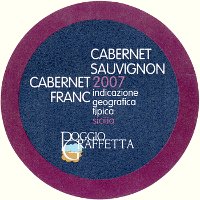
|
|
Cabernet Sauvignon Cabernet Franc 2007 |
|
| Poggio Graffetta (Sicily, Italy) | |
| Grapes: Cabernet Sauvignon, Cabernet Franc | |
| Price: € 9.50 | Score: |
| This wine shows an intense ruby red color and nuances of ruby red, moderate transparency. The nose reveals intense, clean, pleasing and refined aromas which start with hints of plum, black currant and black cherry followed by aromas of violet, vanilla, tobacco and carob. The mouth has good correspondence to the nose, a tannic attack and however balanced by alcohol, good body, intense flavors, pleasing roundness. The finish is persistent with flavors of plum, black currant and black cherry. This wine ages for 6 months in cask followed by 3 months of aging in steel tanks. | |
| Food Match: Roasted meat, Broiled meat and barbecue, Stewed meat | |
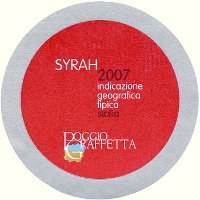
|
|
Syrah 2007 |
|
| Poggio Graffetta (Sicily, Italy) | |
| Grapes: Syrah | |
| Price: € 9.50 | Score: |
| This Syrah shows a brilliant ruby red color and nuances of ruby red, moderate transparency. The nose denotes intense, clean, pleasing and refined aromas which start with hints of black currant, plum and black cherry followed by aromas of blueberry, violet, blackberry, vanilla and carob. The mouth has good correspondence to the nose, a tannic attack and however balanced by alcohol, good body, intense flavors. The finish is persistent with flavors of black currant, plum and black cherry. Half of this Syrah ages for 6 months in barrique. | |
| Food Match: Broiled meat and barbecue, Roasted meat, Braised and stewed meat with mushrooms | |
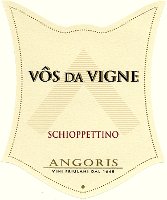
|
|
Colli Orientali del Friuli Schioppettino Vôs da Vigne 2006 |
|
| Angoris (Friuli Venezia Giulia, Italy) | |
| Grapes: Schioppettino | |
| Price: € 13.50 | Score: |
| Colli Orientali del Friuli Schioppettino shows a brilliant ruby red color and nuances of ruby red, moderate transparency. The nose denotes intense, clean, pleasing and refined aromas that start with hints of cherry, plum and raspberry followed by aromas of blueberry, blackberry, violet and cyclamen. The mouth has good correspondence to the nose, a slightly tannic attack and however balanced by alcohol, good body, intense flavors, agreeable. The finish is persistent with flavors of cherry, plum and raspberry. Colli Orientali del Friuli Schioppettino ages in steel tanks. | |
| Food Match: Cold cuts, Stuffed pasta with mushrooms, Sauteed meat, Roasted meat | |
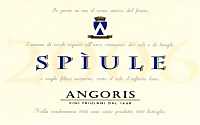
|
|
Colli Orientali del Friuli Bianco Spiule 2006 |
|
| Angoris (Friuli Venezia Giulia, Italy) | |
| Grapes: Chardonnay (50%), Friulano (15%), Ribolla Gialla (25%) | |
| Price: € 16.00 | Score: |
| Colli Orientali del Friuli Bianco Spiule shows a brilliant straw yellow color and nuances of straw yellow, very transparent. The nose reveals intense, clean, pleasing and refined aromas which start with hints of apple, banana and plum followed by aromas of almond, hawthorn, pineapple, broom, pear, vanilla and rosemary. The mouth has good correspondence to the nose, a crisp attack and however balanced by alcohol, good body, intense flavors, pleasing roundness. The finish is persistent with flavors of banana, plum and almond. The Chardonnay ages for 4 months in barrique, whereas the Friulano and Ribolla Gialla grapes age for 4 months in steel tanks. Colli Orientali del Friuli Bianco Spiule ages for 12 months in bottle. | |
| Food Match: Stuffed pasta, Mushroom soups, Roasted white meat, Roasted fish | |
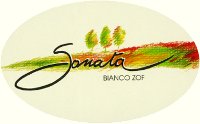
|
|
Colli Orientali del Friuli Bianco Sonata 2007 |
|
| Zof (Friuli Venezia Giulia, Italy) | |
| Grapes: Chardonnay, Sauvignon Blanc | |
| Price: € 8.20 | Score: |
| Colli Orientali del Friuli Bianco Sonata shows a brilliant straw yellow color and nuances of straw yellow, very transparent. The nose denotes intense, clean, pleasing and refined aromas that start with hints of banana, acacia and peach followed by aromas of apple, pineapple, broom, pear, mineral and hints of vanilla. The mouth has good correspondence to the nose, a crisp attack and however balanced by alcohol, good body, intense flavors, pleasing roundness. The finish is persistent with flavors of banana, peach and apple. Colli Orientali del Friuli Bianco Sonata ages in barrique and cask for 8 months. | |
| Food Match: Stuffed pasta, Stewed fish, Sauteed white meat with mushrooms | |

|
|
Colli Orientali del Friuli Picolit 2004 |
|
| Zof (Friuli Venezia Giulia, Italy) | |
| Grapes: Picolit | |
| Price: € 17.90 - 500ml | Score: |
| Colli Orientali del Friuli Picolit shows a brilliant golden yellow color and nuances of golden yellow, very transparent. The nose reveals intense, clean, pleasing and refined aromas which start with hints of dried apricot, candied fruits and honey followed by aromas of peach jam, raisin, chamomile, orange peel, vanilla, litchi and lavender. The mouth has good correspondence to the nose, a sweet and round attack, however balanced by alcohol, good body, intense flavors, pleasing crispness. The finish is persistent with flavors of dried apricot, raisin and honey. Colli Orientali del Friuli Picolit ages in barrique. | |
| Food Match: Confectionery, Hard cheese | |
News |
|
In this section are published news and information about events concerning the world of wine and food. Whoever is interested in publishing this kind of information can send us a mail to our address.
|
AquavitaeReview of Grappa, Distillates and Brandy |
|
|
| Distillates are rated according to DiWineTaste's evaluation method. Please see score legend in the "Wines of the Month" section. |
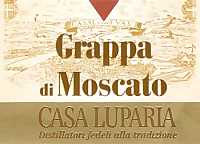
|
|
Grappa di Moscato |
|
| Casa Luparia (Piedmont, Italy) | |
| Raw matter: Pomace of Muscat Blanc | |
| Price: € 11.50 - 50cl | Score: |
| This grappa is colorless, limpid and crystalline. The nose denotes intense, clean and pleasing aromas of grape, peach, pear, candied fruits, white rose and orange, with almost imperceptible alcohol pungency. In the mouth has intense flavors, with perceptible alcohol pungency which tends to dissolve rapidly, good correspondence to the nose, pleasing roundness, balanced sweetness. The finish is persistent with flavors of grape, peach and banana. A well made grappa produced with a discontinuous alembic still operating at low pressure. Alcohol 42%. | |
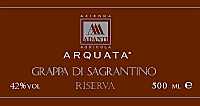
|
|
Grappa di Sagrantino Riserva |
|
| Adanti (Umbria, Italy) | |
| (Distiller: Distillerie Aquileia) | |
| Raw matter: Pomace of Sagrantino | |
| Price: € 25.00 - 500ml | Score: |
| This grappa shows a brilliant amber color, limpid. The nose reveals intense, clean and pleasing aromas of prune, chocolate, vanilla, tobacco, hazelnut, dried fig and praline, with almost imperceptible alcohol pungency. In the mouth has intense flavors, with perceptible alcohol pungency which tends to dissolve rapidly, pleasing roundness, good correspondence to the nose, balanced sweetness. The finish is persistent with flavors of chocolate, prune and hazelnut. This grappa is distilled with a steam operated discontinuous alembic still and ages for 18 months in barrique. Alcohol 42%. | |
Wine Parade |
|
|
| The best 15 wines according to DiWineTaste's readers. To express your best three wines send us an E-mail or fill in the form available at our WEB site. |
| Rank | Wine, Producer | |
|---|---|---|
| 1 |
| Sforzato di Valtellina San Domenico 2002, Triacca (Italy) |
| 2 |
| Aglianico del Vulture La Firma 2004, Cantine del Notaio (Italy) |
| 3 |
| Blanc des Rosis 2006, Schiopetto (Italy) |
| 4 |
| Sangiovese di Romagna Superiore Riserva Thea 2005, Tre Monti (Italy) |
| 5 |
| Chianti Classico Riserva Novecento 2000, Dievole (Italy) |
| 6 |
| San Leonardo 2001, Tenuta San Leonardo (Italy) |
| 7 |
| Sagrantino di Montefalco Collepiano 2003, Arnaldo Caprai (Italy) |
| 8 |
| Bradisismo 2003, Inama (Italy) |
| 9 |
| Moscato d'Asti 2007, Vignaioli di S. Stefano (Italy) |
| 10 |
| Villa Gresti 2004, Tenuta San Leonardo (Italy) |
| 11 |
| Arkezia Muffo di San Sisto 2004, Fazi Battaglia (Italy) |
| 12 |
| Wine Obsession 2001, Vignamaggio (Italy) |
| 13 |
| Barolo Bussia 2001, Prunotto (Italy) |
| 14 |
| Merlot 2004, Castello delle Regine (Italy) |
| 15 |
| Collio Bianco Col Disôre 2004, Russiz Superiore (Italy) |
| |||||||
Privacy Policy | |||||||


| Copyright © 2002-2024 Antonello Biancalana, DiWineTaste - All rights reserved |
| All rights reserved under international copyright conventions. No part of this publication and of this WEB site may be
reproduced or utilized in any form or by any means, electronic or mechanical, without permission in writing from DiWineTaste. |